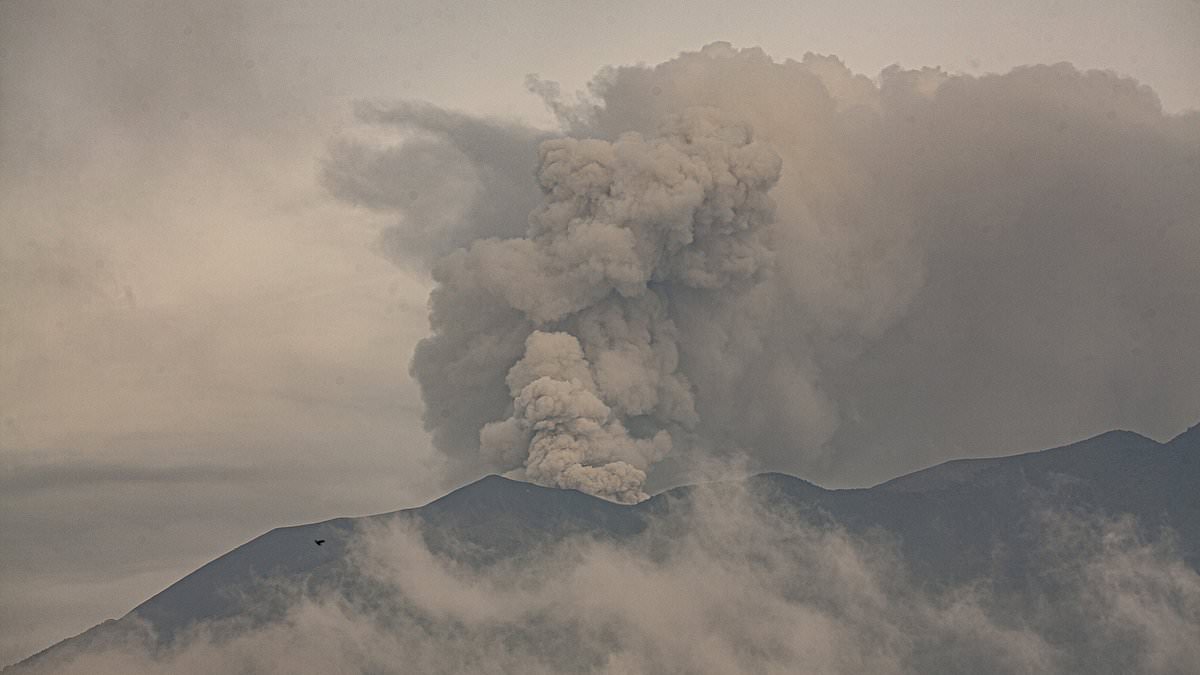Indonesia’s Mount Marapi today spewed columns of volcanic ash as authorities raised the volcano’s alert status to the highest level, a month after an eruption that left 23 dead.
Indonesian authorities had increased the alert status of Mount Marapi in the West Sumatra province to the second-highest level on Tuesday and imposed a 4.5-kilometre exclusion zone from its crater, with the area still out of bounds.
Hundreds of residents have been evacuated to temporary shelters.
It comes after Mount Lewotobi Laki-Laki in Indonesia erupted on Wednesday, spewing ash clouds 6,561 feet above its peak.
That eruption followed weeks of heightened volcanic activity on the mountain, located on the island of Flores in eastern Indonesia, and prompted the local government to issue an evacuation order for nearby residents.

Mount Marapi spews columns of volcanic ash during an eruption as seen from Tanah Datar District, West Sumatra, Indonesia on January 13, 2024

Mount Marapi spews columns of volcanic ash during an eruption as seen from Tanah Datar District, West Sumatra, Indonesia on January 13, 2024.
‘The communities are urged to immediately evacuate to safe points to avoid hot ash (from the volcano),’ local official Benediktus Bolibapa Herin said on Wednesday.
Local authorities have established two temporary shelters, which are currently accommodating about 5,000 people, Herin said.
On December 7, the search ended for any more victims among climbers who were caught by the eruption of the Mount Marapi volcano days earlier.
West Sumatra Police Chief Suharyono said that the discovery of the body of a female university student had raised the confirmed death toll to 23.
About 75 climbers started up the nearly 9,480-foot mountain and were on the volcano when it erupted the following day.
Some 52 climbers were rescued after the initial eruption, with about a dozen taken to hospitals with serious to minor injuries.
Smaller eruptions since then have spewed more ash into the air.
On December 13, Mount Marapi spewed clouds of ash half a kilometre high into the sky, the country’s volcanology agency said.
It erupted at around 6 a.m. local time (2300 GMT) and again at noon, Hendra Gunawan, the chief of Indonesia’s volcanology agency, said.
The eruption, he added, was relatively minor given recent activity, but the alert for the volcano was at the second-highest level.
On December 22, volcanic ash from Mount Marapi shut down airports and blanketed nearby communities on the island of Sumatra.

Mount Marapi volcano spews volcanic materials during an eruption, as seen from Nagari Bukik Batabuah in Agam, West Sumatra province, Indonesia, January 13, 2024

Mount Marapi volcano spews volcanic materials during an eruption, as seen from Nagari Bukik Batabuah in Agam, West Sumatra province, Indonesia, January 13, 2024

Mount Marapi spews columns of volcanic ash during an eruption as seen from Tanah Datar District, West Sumatra, Indonesia on January 13, 2024

Mount Marapi spews columns of volcanic ash during an eruption as seen from Tanah Datar District, West Sumatra, Indonesia on January 13, 2024

Mount Marapi spews columns of volcanic ash during an eruption as seen from Tanah Datar District, West Sumatra, Indonesia on January 13, 2024

Mount Marapi spews columns of volcanic ash during an eruption as seen from Tanah Datar District, West Sumatra, Indonesia on January 13, 2024
The volcano began belching ash that reduced visibility hundreds of kilometres away, said Indra Saputra of Indonesia’s Center for Volcanology and Geological Disaster Mitigation.
Marapi is known for sudden eruptions that are difficult to predict because they are not caused by a deep movement of magma, which sets off tremors that register on seismic monitors.
The volcano has been at Indonesia’s third highest alert level since 2011, indicating above-normal volcanic activity that means climbers and villagers must stay more than 3 kilometres from the peak, according to the Center for Volcanology and Geological Disaster Mitigation.
Although hikers are not supposed to enter the danger zone, local officials have acknowledged that many people likely advance higher than permitted.
Marapi is among more than 120 active volcanoes in Indonesia. The country is prone to seismic upheaval due to its location on the Pacific ‘Ring of Fire,’ an arc of volcanoes and fault lines encircling the Pacific Basin.
